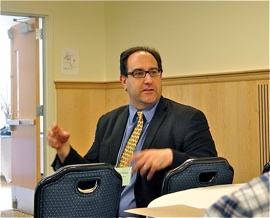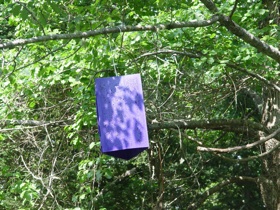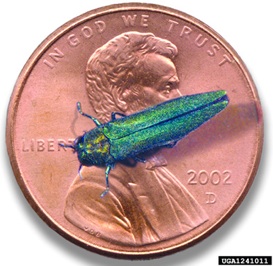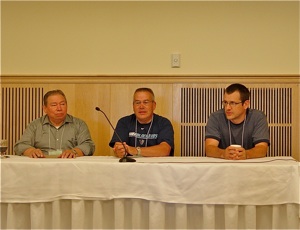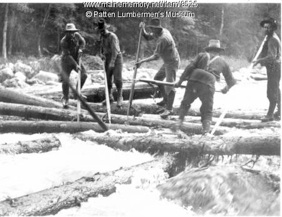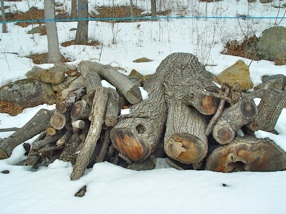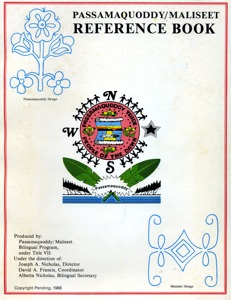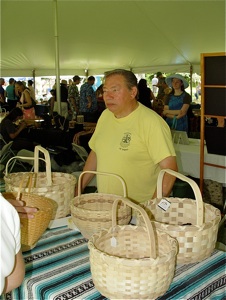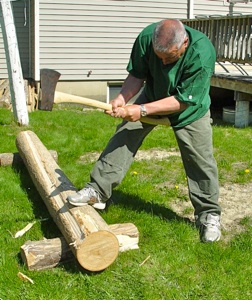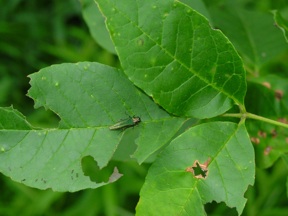Name: Emerald Ash Borer Project
Contact: Dr. Darren J. Ranco
Chair of Native American Programs
Associate Professor of Anthropology
Coordinator Native American Research
University of Maine
5724 Dunn Hall #303
Orono, Maine 04469-5724
Phone: 207-581-9485
Email: darren.ranco@maine.edu
If You Suspect Emerald Ash Borer:
1-866-322-4512
Website:
What Makes The Emerald Ash Borer Threat Unique to Maine’s Forests?
In a farm project which has included stories of Native American gathering traditions, forestry, and
the chestnut restoration program, it seemed only fitting to dedicate some attention to the very real threat of an emerald ash borer infestation to the ash trees found in Maine. Thanks to the kindness of Dr. Darren Ranco, Unique Maine Farms was welcome to attend the Protecting the Ash for Future Generations V: Kolunkayowan Wikpiyik symposium on June 21, 2013, at the University of Maine at Orono. Dr. Ranco is the leader of a Maine’s Sustainability Solutions Initiative team that has formed collaborations throughout the state to prevent, detect, and respond to the emerald ash borer.
There are three species of ash trees in Maine. The white ash tree (Fraxinus americana L.) and the green or red ash tree (Fraxinus pennsyvanica Marsh.) have been valued for their hard, tough wood. Individuals interested in making items such as oars, baseball bats, hockey sticks, snowshoes, and handles for tools or farm implements have always prized these species of ash. Brown or Black Ash (Fraxinus nigra Marsh.) is known for its durable and pliable characteristics. It has been used for hardwood pulp, flooring, caskets, and barrel hoops over the years.
Indians have believed that man emerged from the brown ash tree. The tree is regarded as sacred. The recitation of the story of Gluskap, the hero of the Wabanaki people, who was said to emerge from the brown ash tree, was told by Maliseet basketmaker, Fred Tomah, and included in “The Story of Maine” in MPBN’s “People of the Dawn” program. Photos of the paintings of artist John Foley’s interpretation of Gluscap and the ash tree creation story, that are on exhibit at the Wabanaki Cultural Center in Calais, are included in this profile, with permission from the artist.
For thousands of years, Native Americans have harvested the brown or black ash trees to make both utilitarian and fancy baskets. The significant role that baskets have played in the lives of Indians in Maine is illustrated by how so many basket-related words figure predominantly in their language. With the permission of Alberta Nicholas (kindly arranged by Donald Soctomah) a webpage of many of the Passamaquoddy/Maliseet words that are used to depict fancy baskets and another webpage of the Passamaquoddy/Maliseet words that are used to depict coarse baskets are included in this project.
The source of these basket-related words originated in the Passamaquoddy/Maliseet Reference Book that was produced by the Passamaquoddy/ Maliseeet Bilingual Program under the direction of Joseph A. Nicholas, David A. Francis, and Alberta Nicholas. These long lists of basket-related words have been included in this project to illustrate the very significant way that baskets have always figured in the Native American culture.
Members of the Maine Indian Basket Alliance and many other entities in Maine are deeply concerned by the threat of the emerald ash borer. It is an invasive beetle from Asia likely introduced to the United States from infested shipping crates. It was first detected in Michigan in 2002. Since that time, millions of ash trees have been decimated in the Midwest and in other parts of the country and Canada. The emerald ash borer has now been documented in two provinces in Canada and in twenty-two states including Connecticut and Massachusetts. In late March of 2013, it was detected in the Merrimac region of nearby New Hampshire.
Dr. Darren Ranco, Chair of Native American Programs, Associate Professor of Anthropology, and Coordinator of Native American Research at the University of Maine, was fully aware of how the threat of the emerald ash borer could deeply affect the Native Americans who depend on the brown ash for their livelihoods. Since 2009, he has encouraged the collaboration of many Native basketmakers and harvesters with foresters, scientists, researchers, volunteers, landowners, and state and federal agencies. The goal is that all these individuals will come together and address the threat of an invasive insect that could drastically affect Indians who rely on the ash tree for their baskets and Maine people who count on ash for the many uses of the wood. The significance of the ash tree has been illustrated in the webpages of four Native American brown ash basketmakers from Maine who are included in this project: Eldon Hanning, Gerald “Butch” Jacobs, Richard Silliboy, and Fred Tomah.
Several foundations have generously stepped forward to fund research to address the issues surrounding emerald ash borer infestation. The Maine’s Sustainability Solutions Initiative, which has helped to support the work of Dr. Ranco and his colleagues and members of the Emerald Ash Borer project, is a program of the Senator George J. Mitchell Center. It was started with a twenty million dollar grant from the National Science Foundation in 2009, to Maine EPSCoR at the University of Maine. EPSCor is a program which advances Maine’s research capacity and competitiveness for a sustainable future.
For several years, Dr. Ranco has coordinated a day-long Protecting Ash for Future Generations Kolunkayowan Wikpiyik Symposium at the University of Maine at Orono where all different concerned individuals gather to discuss developments and strategies. Several Native basketmakers and harvesters attend. This all-inclusive approach that respects the significance of the brown ash tree to Native people in its work to combat the invasive beetle is the first of its kind in the country. Dr. John Daigle, Dr. Bill Livingston, Kara Lorion, and Suzanne Greenlaw from the University of Maine are members of the SSI Team, along with Jennifer Neptune and Theresa Secord from the Maine Indian Basketmakers Alliance.
Dr. Ranco arranged for a group of Maine basket makers to attend a conference on the emerald ash borer in Michigan in 2010. They were able to witness firsthand the havoc that had been wreaked to the ash trees in the Michigan forests by the invasive beetle. The emerald ash borers lay eggs between layers of bark and in bark crevices. These eggs take about two weeks to hatch. Emerald ash borers feed on the inner bark and phloem. They leave a serpentine pattern as they bore through the wood. After going through four feeding stages the larvae overwinter as prepupae. Adult emerald ash borers are active in the summer, emerging in late May and June. They live for four to six weeks. According to Dr. Nate Siegert, a Forest Entomologist with the USDA Forest Service, the emerald ash borers are “physiologically capable of flying almost a mile a day, but tend to disperse much shorter distances when ash is present.” Siebert continued, “People, however, can readily move emerald ash borers great distances in infested ash materials such as logs or firewood.”
Dr. Bill Livingston, a University of Maine associate professor of forest resources, and Kara Lorion, have worked with Native brown ash harvesters to locate the stands of brown ash in the state that are considered to have the best wood for making baskets. They have been mapping out these areas so that immediate protection and prevention of infestation can take place to attempt to save these prized trees.
Colleen Teerling, a Forest Entomologist with the Maine Forest Service, has been conducting biosurveillance using a native hunting wasp, which consumes wood-boring beetles, to help monitor for emerald ash borer. The wasp is netted as she returns to her nest with prey and the prey is identified to see if there is any evidence of the invasive beetle. Colleen and others are also involved in the trap tree program where trees are girdled. Emerald ash borers are attracted to the stressed ash tress that have been girdled and they tend to lay more eggs for emerald ash borer detection and monitoring. Individuals interested in volunteering to help with the trap trees “log-peeling parties” or monitoring the non-stinging wasp colonies can contact Colleen Teerling at 207-287-2791 or email: colleen.teerling@maine.gov
Purple emerald ash borer prism traps have been deployed throughout the state through a federal program. In 2013, there were 852 of these traps placed in Maine. They have proven to be a good educational outreach tool. Various individuals in the state have stepped forward to help with spreading the word about invasive insects. One particularly impressive volunteer is eleven-year-old home-schooled student, Wyatt Laprise. He attended a training about invasive forest insects and has helped out at various events such as the 2013 Common Ground Fair. For learning more about volunteering with the invasive forest insects program, individuals can contact Lorraine Taft at 207-832-6241 or email: lorraine.taft@gmail.com
Detecting the presence of the emerald ash borer can be challenging because the damage to infected trees may not become apparent sometimes until three years or more have gone by. Some of the signs of infestation include dead branches in the upper crown, vertical bark splits, woodpecker damage, and excessive epicormic branching which is when an unusual number of new branch shoots are evident in areas along the vertical length of the tree.
One recommended way to prevent emerald ash borer infestation is not to move firewood from your home. The purchase of only local firewood is suggested. Transporting firewood from another state into Maine is actually illegal thanks to the efforts of Dr. John Daigle and other concerned individuals.
Ann Gibbs, with the Maine Department of Agriculture, shared information about how the state hopes to regulate pathways so that the threat of emerald ash borer can be controlled. She spoke at the Emerald Ash Borer Symposium about the fourteen Maine towns that have provided trap trees and the pilot project in Brunswick. Over the years, many towns throughout Maine chose ash trees to line their streets. The state has been involved with collaborative efforts with other states and provinces under the New England Forest Protection Compact. They have also focused on outreach and the “Burn It Where You Buy It” message.
Unique Maine Farms hopes to keep current about the developments of the emerald ash borer on this website. There have been efforts to study the emergency response plans in other states and discussions about jurisdiction issues, best communication practices, quarantines of infected areas, and attempts to collect and save brown ash seeds. Individuals who are actively working to
prevent, detect, and respond to the emerald ash borer are encouraged to share any updates.




